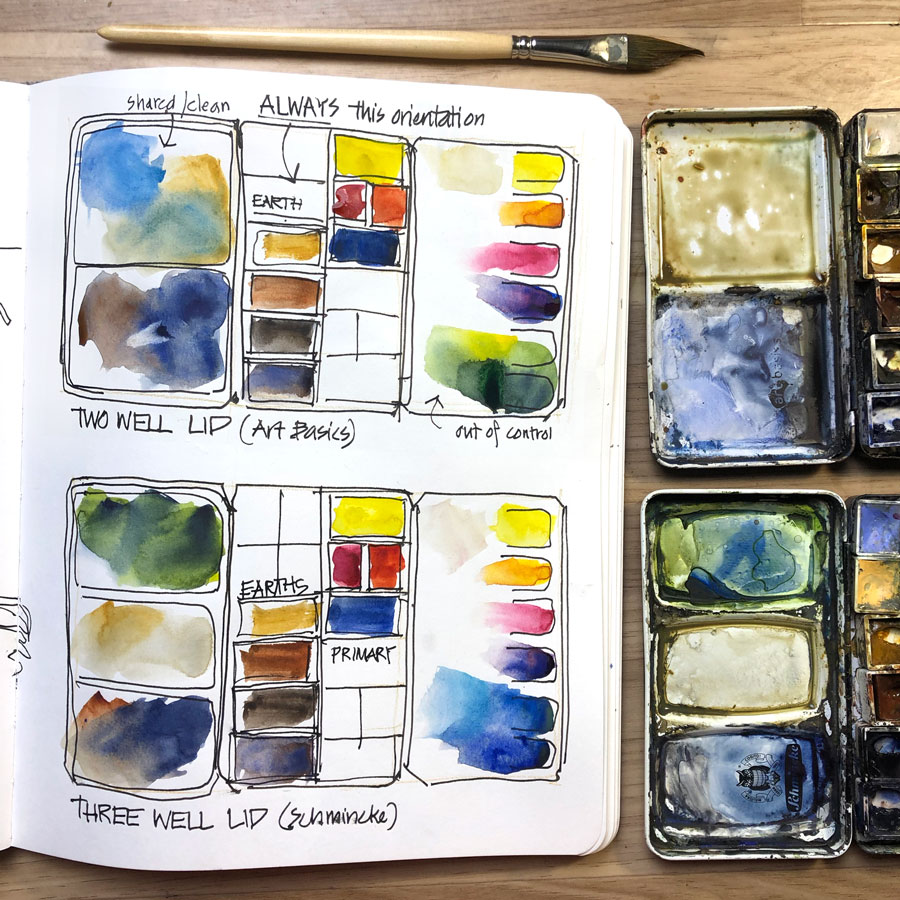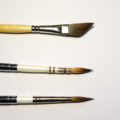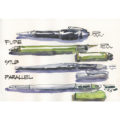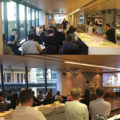This week in my SketchingNow Watercolour On Location course, I was asked to explain how I use my palette and my dedicated mixing areas. I thought this was a good topic to share with everyone so here is a sketch to explain it.
I always place my palette in the same orientation when I sketch – with the large wells and the earth colours on the left and the primary colours and smaller mixing areas on the right. This is super important as I want to train my muscle memory to know where the various colours are, so that even in dim light I’m able to mix colours because I know exactly where they are.
And then I have dedicated mixing areas for various hues. I don’t always stick to these, but if I accidentally mix a colour in the ‘wrong’ spot I will clean it up before starting the next sketch. Note: As a general rule I do not clean my palette after every sketch as I am often able to re-use the dry paint.
A number of years ago I was using a tin with a three-well lid from Schmincke but when I wore that out, I reluctantly switched to a tin with a two-well lid as it was easier and cheaper to source here in Australia. But this year while I was in Europe I got another Schmincke tin and it has made a huge difference.
You can see from this image that my earth colours get the priority! I like having a grey, brown, black well and then a lighter softer warm grey one.
The other hue for which I like having a good mixing area is green as I’ll have various versions half-mixed in the one area. In the two-well tin I had to mix green on the right side and it got out of control. So it’s fantastic now to have a dedicated well for it in the new tin.
I don’t mix blue in my palette much (often mix it on the page wet-in-wet) so using the right side with the smaller wells is not a problem. In the two-well tin I used to have to clean the top left well if I needed to mix a good amount of blue.
As for other colours – the small mixing areas on the right side work okay for me. There are always compromises when you use a small palette on location, but I have made this tin do the job for me over the years.
Note: this is a left-handed palette. If I was right-handed I would flip everything.
Do you do a similar thing – or do you just mix randomly on your palette?








19 Comments
Hi Liz !
Thank you for sharing this. I do admire people who are disciplined on their palette.
Preparing for your course I rearranged my colors and have a bit of a problem because I am used to my old way. It will take me a while go get used to dip in the right pans.
As for the mixing places, I do not have good habits which puts me in trouble sometimes…. lol
Diane
I methodically and picky about a clean palette… so of course similar colors are grouped together to reduce on cross contamination. My mixing area can be messy, but not my paint pans. When I see palettes where artists pan colors are unrecognizable I cringe!
Hi Kate, I understand that! 🙂 I allow my paints to mix during a sketch but do try and clean them at the end of the day….its normally my yellow that is the problem!
Thanks for this post, Liz. I am also very disciplined about my palette, especially about keeping it clean between paintings. I’ve just switched to a Schmincke palette in advance of a Plein Air trip to Tuscany, but have set it up in the same order as my normal studio palette. So it’s interesting to see how you use the wells. Right now my burning question is whether the airlines will allow me to carry my brushes in my hand luggage. Pointed objects. I hate to put them in checked baggage in case the bag is lost. Any recommendations?
You can take knitting needles on a plane, so paintbrushes should be no problem.
Hi Liz,
Thank you for this helpful post. Did you modify the pan holder as you described in past posts?
Hi Joanna,
Removing the clips? Yes
Was it easy to remove the clips/rails without damage to the palette?
Thanks for sharing this. I tend to always orient my palette the same way and try to keep the same colors in the same mixing areas all the time. Like you, I like to know where my colors are.
I have some of the cheaper palettes with the 2 big wells. I turned them into 4 medium size wells with some hot glue.
I’m not completely consistent about the use of my mixing wells, but I do always orient my palette tin the same way and I’m methodical regarding locations of pans. My strategy there is to place the yellows at top left (I’m right-handed). This means I’m not ever carrying a brush loaded with some other colour over the yellow pan in order to mix or get to my sketchbook. That in turn helps keep the yellows clean. This appears to be what you’ve done with your pans, in reverse. Similarly, too, I tend to mix yellow-based colours over at top left
Curious to know why this orientation is for left handed painters. I’m right handed and orient my travel tin in the same way that you do. Is there a reason for keeping the larger mixing wells on the side that matches your dominant hand?
Hi Barbara!
While I can easily mix to the left or the right of the paints, I find that it’s best when my hand is not covering anything – therefore I prefer mixing in wells to the left of my paints – hence the big wells on the left and the smaller wells that I don’t use as much on the right.
I love your comment about being left handed!! I was looking at your mixing area and I was thinking… “why this appears just perfect to me? “ Because I’m left handed too!! I always orient my palette like that!
Ah yes! lefties think differently 🙂 Thanks for the comment Gabriella!
I’m on a catch up blitz and this came up in the livestream today- so going “down in the weeds”… I love this way of organising a palette so that you can reuse/ not waste. I remember you saying in an earlier video, Liz, that you always work with palette, paper and water in the same orientation so you can work without thinking about where things are- this seems to me an excellent extension of that idea! Thanks for sharing Liz!
Hi Astrid. Yes it’s all part of building muscle memory!
Hi I just came across your blog. This is a very interesting way to train yourself. My palettes are always a mess, especially the small ones, I mix it at random, which by the end of a painting becomes so chaotic. Will give this a try, seems very streamlined and feel like I could do with some discipline.
Welcome Shalmika. I hope you can get a layout to work for you. I think it makes it heaps easier to do reflex sketching when you are disciplined about mixing areas as you can rely on muscle memory!
NEWSLETTER
Subscribe for first notification of workshop + online classes and more.